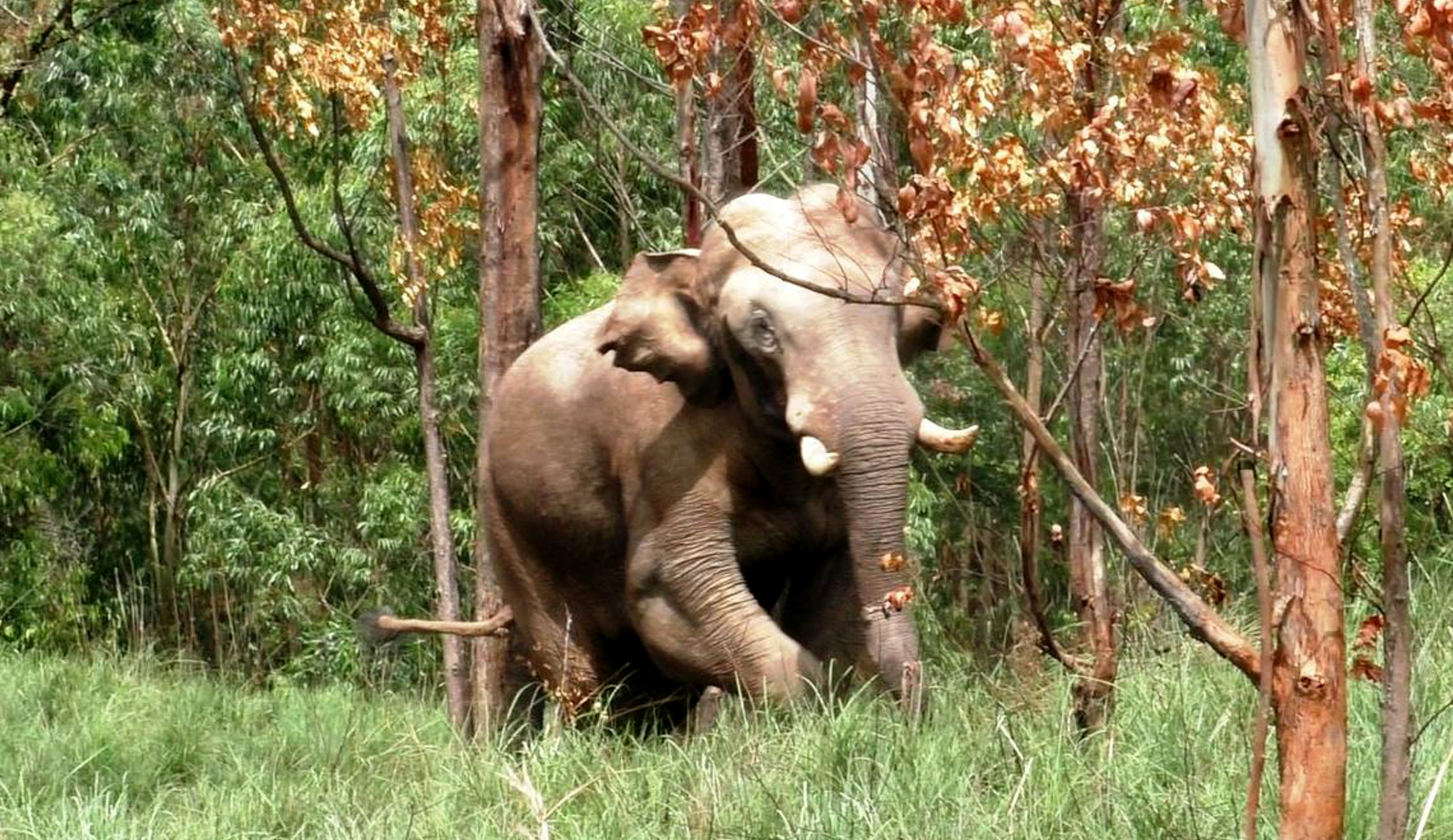How a court order exposed organised lies and adverse propaganda targeting a wild elephant with a penchant for rice.

Arikomban before being captured from Chinnakanal in Idukki. Photo: Jomon Pampavalley.
Animal lovers felt a lump in their throats as a photograph of an elephant peacefully sleeping in a tea estate near Kerala’s Munnar recently went viral on social media.
The tusker, Arikomban, was sleeping, oblivious to the fact that his days of roaming free were numbered.
A dummy ration shop had been set up to snare him at Cement Palam near Chinnakanal. Two kumki, or trained, elephants, Vikram and Surya, had already arrived to force him into submission. Two more were to arrive soon.
Eight teams of more than 30 people were in Munnar to tranquilize and capture him, and to take him to Kodanad, about 100 km away from his home.
A kraal, or a wooden enclosure, was being readied to confine and train him to obey humans.
Aged around 35, the elephant, frequently sighted with a herd of cow elephants and calves, was unaware of all these developments when he stretched out and caught a shut-eye.
However, the High Court of Kerala, on Wednesday, 29 March, intervened. A division bench of Justice AK Jayashankaran Nambiar and Justice Gopinath P rejected the government’s plea to capture the animal.
Earlier, a Thiruvananthapuram-based activist had moved the court, challenging the government’s decision to capture Arikomban, as the locals have named him.
Arikomban is a portmanteau of the Malayalam words Ari, meaning rice, and Komban, tusker. The elephant is in the habit of raiding rations shops of the area and eating rice.
The high court ruled in favour of the animal. It constituted a Committee of Experts (CoE) to suggest measures to prevent it from straying into human habitations. The five-member CoE was also told to make its recommendations by 5 April.
The court also ordered that the kumki elephants and the personnel should remain for safeguarding human settlements. The ultimate aim, the court said, is to strike a balance between the conflicting interests of residents and the tusker.
The bench also observed that if the tusker posed a threat to the people, it should be tranquilised and temporarily immobilised for radio-collaring, so that its movements could be tracked.
With the high court’s order, the much-celebrated Operation Arikomban came to a grinding halt.
The response to the court order was immediate. People of Sinkukandam and 301 Colony at Chinnakanal took out a protest march to the kumki camp at Cement Palam the same day, even destroying the Forest Department’s barricades at Sinkukandam.
A Joint Action Council, formed to demand the capture of Arikomban, called for a 12-hour dawn-to-dusk hartal in 13 panchayats on Thursday. The Youth Congress pledged support to the hartal.
Three panchayats, Bison Valley, Senapathi, and Rajakkad, later withdrew from the shutdown. The council also blockaded the Kochi-Dhanushkodi National Highway-85 at Pallivasal. It alleged that the court had failed to appreciate the ground reality.
Kerala’s Minister for Forest AK Saseendran challenged the judges to stay in areas frequented by wild elephants. He had earlier cut a sorry figure, saying all tigers in Wayanad should be culled. He later clarified that he meant only man-eaters.
Cyber activists of major political parties, too, came out in support of the agitators, demanding the immediate capture of Arikomban. They wanted to convert Arikomban into a kumki.
The tusker got the name Arikomban due to his penchant for rice. An elephant with short tusks, a stout physique, and a broad cranium, raids local ration shops and kitchens of houses to feed on rice, jaggery, and salt.
The residents have branded Arikomban notorious, claiming that he had killed 12 people so far. The claim, however, remains unsubstantiated.
Forest officials and a sizable number of locals confirmed that Arikomban has caused no harm to life and property in the region so far, other than occasionally raiding ration shops and houses for rice.
Stories of the elephant unleashing terror at night are also being told without adequate proof.
Such narratives have vilified the elephant. A campaign was unleashed through local and social media a few months ago, painting Arikomban as a dangerous elephant roaming around human settlements and killing people.
Idukki, of late, has witnessed several protest rallies, public meetings, and road blockades, demanding the capture and relocation of the elephant. In recent history, very few other elephants and wild animals have become the focal point of such organised propaganda.
While delivering the order, the high court pointed at the real cause of the human-animal conflict in the Anayirangal area.
Realising that it was part of the reserve forests 23 years ago, the court asked the Forest Department to explain the rationale for allowing people to settle in an elephant habitat and putting them in danger.
According to Forest Department sources, the Chinnakanal-Anayirangal area was a natural wild elephant habitat till 2002, when the policymakers made a grave mistake.
The then-AK Antony-led UDF government relocated 301 poor families of tribespeople, who were alienated from their landholdings by powerful settlers. Instead of restoring their land, the government took the easy route and assigned reserve forests to the landless tribals.
Their settlement later came to be known as the 301 Colony.
Incidentally, the then Divisional Forest Officer in Munnar, Prakriti Srivastava, had opposed the UDF government’s move. She pointed out that the rehabilitation colony was in a traditional elephant corridor, connecting the Chinnar Wildlife Sanctuary with the Periyar Tiger Reserve.
Contrary to the propaganda, only 41 people belonging to 15 families are living in the area now. The rest of the 301 tribal families had already moved out, unable to withstand the presence of many elephant herds.
The high court has enquired about the possibility of relocating the remaining tribal families to safer places.
Incidentally, the Forest Department submitted an affidavit before the court, saying the relocation of the remaining families would provide a lasting solution.
Elephants will inevitably frequent the corridor as it is the way to the Anayirangal Dam, which holds adequate water even in summer.
Incidentally, not all protesters are tribespeople. There are a set of non-tribals who, in course of time, have taken over the land assigned to tribesmen.
They thwart any relocation move by creating the impression that it is impractical. Even in 2006, there was an official move to shift the tribal families to revenue land in Vallakadavu and merge the existing colony and its surroundings with the Chinnakanal sanctuary.
The Anayirangal colony remains the major obstruction in the elephant path stretching from Anamudi Tiger Reserve of Tamil Nadu and Parambikulam in Kerala to Periyar and Mathikketan Shola in Idukki.
Experts say the capture of Arikomban would not solve the issue. If not Arikomban, it will be another tusker as more and more settlements are coming up near forest areas.
The court, too, referred to the possibility of another tusker raiding the human habitation, even if Arikomban is translocated to Kodanad.
There are other tuskers that roam the area: Mottavalan, Chakkakomban, and Padayappa. The settlers claim that they, too, were creating a menace in the region.

Padayappa, a wild elephant, one of the elephants causing damage to properties in the Idukki district. (Creative Commons)
A demand is likely to be raised to capture and relocate others too, after Arikomban. It has been alleged that barring Padayappa, the three other elephants had killed 15 people.
There are allegations of vested interests — tourism lobbies and land mafia — using tribespeople and plantation workers as tools to create a scare that would help them continue their illegal activities.
Local politicians said these tuskers destroyed 128 houses in the Munnar region in the past six months. Towards the end of January, forest watcher G Sakthivel, 48, was trampled to death, and Arikomban has been accused of murdering the elephant expert.
The blame was put on Arikomban based on circumstantial evidence. He was sighted in the area before Sakthivel’s death.
Official data suggest habitat destruction as the root cause for the prevailing elephant attacks in the region. Private individuals obtained land rights by fudging documents in several elephant corridors.
At least 38 elephants have been trapped in an area — cut off from the rest of the forests — because of fragmentation, and they often raid crops due to food scarcity, forest officials said.
Fences erected by estate owners are also worsening the situation in areas like Pondimala, Chinnakanal, Munnar, Chinar, Sinkukandam, Adukidannapara, Udumbanchola, Chellarkovil Mettu, and Mathikettan.
Earlier, forest patches in these areas had direct links with the Periyar tiger reserve, and elephants used to move freely through the path.
Arikomban seems to be trapped in the forests between human inhabitants on one side and the Anayirangal Dam on the other. The other charges against him are yet to be proven, except for his passion for rice.
Forest officials said Arikomban is young and could be trained to become a good kumki elephant.
Now, the demand for capturing and relocating elephants is coming up from different parts of the state, where encroachments on forest lands have been reported.
Palakkad Tusker (PT)-7, now named Dhoni, was one such elephant that was captured on 22 January near Malampuzha in Palakkad following a protest by residents. The possibility of such demands rising from other places, too, cannot be ruled out.
Studies have confirmed that the loss of bull elephants would cause a significant gender disparity in the wild. Of the 27,000-odd Asian elephants in India, only around 1,200 are tuskers.
They are familiar with human dwellings. They are more likely to take risks than female elephants, exposing them to dire aftermaths such as poaching, electrocution, or death on railway tracks in human-dominated landscapes.
Scientific solutions, including adaptation and co-existence, are the possibilities ahead. The Forest Department and the government should be more sensitive, honest, and pragmatic.
Meanwhile, on Thursday afternoon, Arikomban was sighted by the Chinnakanal-Sinkukandam road, followed by a battery of television crews. Chakkakomban, who has developed a taste for jackfruit, too, was in the area.
(Views are personal).

Apr 17, 2024

Apr 17, 2024

Apr 17, 2024

Apr 16, 2024

Apr 16, 2024